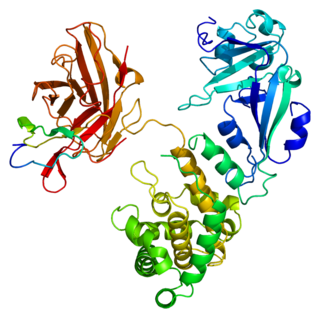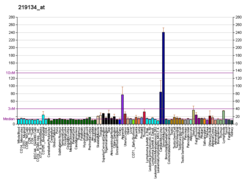
Transforming growth factor alpha (TGF-α) is a protein that in humans is encoded by the TGFA gene. As a member of the epidermal growth factor (EGF) family, TGF-α is a mitogenic polypeptide. The protein becomes activated when binding to receptors capable of protein kinase activity for cellular signaling.

Heparin-binding EGF-like growth factor (HB-EGF) is a member of the EGF family of proteins that in humans is encoded by the HBEGF gene.

EGF-like module-containing mucin-like hormone receptor-like 1 also known as F4/80 is a protein encoded by the ADGRE1 gene. EMR1 is a member of the adhesion GPCR family. Adhesion GPCRs are characterized by an extended extracellular region often possessing N-terminal protein modules that is linked to a TM7 region via a domain known as the GPCR-Autoproteolysis INducing (GAIN) domain.

EGF-like module-containing mucin-like hormone receptor-like 3 is a protein encoded by the ADGRE3 gene. EMR3 is a member of the adhesion GPCR family. Adhesion GPCRs are characterized by an extended extracellular region often possessing N-terminal protein modules that is linked to a TM7 region via a domain known as the GPCR-Autoproteolysis INducing (GAIN) domain.

Brain-specific angiogenesis inhibitor 3 is a protein that in humans is encoded by the BAI3 gene.

Cluster of differentiation 97 is a protein also known as BL-Ac[F2] encoded by the ADGRE5 gene. CD97 is a member of the adhesion G protein-coupled receptor (GPCR) family. Adhesion GPCRs are characterized by an extended extracellular region often possessing N-terminal protein modules that is linked to a TM7 region via a domain known as the GPCR-Autoproteolysis INducing (GAIN) domain.

Cadherin EGF LAG seven-pass G-type receptor 3 is a protein that in humans is encoded by the CELSR3 gene.

Cadherin EGF LAG seven-pass G-type receptor 2 is a protein that in humans is encoded by the CELSR2 gene.

Latrophilin 1 is a protein that in humans is encoded by the ADGRL1 gene. It is a member of the adhesion-GPCR family of receptors. Family members are characterized by an extended extracellular region with a variable number of protein domains coupled to a TM7 domain via a domain known as the GPCR-Autoproteolysis INducing (GAIN) domain.

Latrophilin 3 is a protein that in humans is encoded by the ADGRL3 gene.

Probable G-protein coupled receptor 124 is a protein that in humans is encoded by the GPR124 gene. It is a member of the adhesion-GPCR family of receptors. Family members are characterized by an extended extracellular region with a variable number of protein domains coupled to a TM7 domain via a domain known as the GPCR-Autoproteolysis INducing (GAIN) domain.

GPR113 is a gene that encodes the Probable G-protein coupled receptor 113 protein.

Adhesion G-protein coupled receptor A3 (ADGRA3), also known as GPR125, is an adhesion GPCR that in humans is encoded by the Adgra3 gene.

Cadherin EGF LAG seven-pass G-type receptor 1 also known as flamingo homolog 2 or cadherin family member 9 is a protein that in humans is encoded by the CELSR1 gene.

Latrophilin 2 is a protein that in humans is encoded by the ADGRL2 gene.

Stabilin-1 is a protein that in humans is encoded by the STAB1 gene.

Endosialin is a protein that in humans is encoded by the CD248 gene.

Stabilin-2 is a protein that in humans is encoded by the STAB2 gene.

EGF-like domain-containing protein 7 is a protein that in humans is encoded by the EGFL7 gene. Intron 7 of EGFL7 hosts the miR-126 microRNA gene.

Adhesion G protein-coupled receptors are a class of 33 human protein receptors with a broad distribution in embryonic and larval cells, cells of the reproductive tract, neurons, leukocytes, and a variety of tumours. Adhesion GPCRs are found throughout metazoans and are also found in single-celled colony forming choanoflagellates such as Monosiga brevicollis and unicellular organisms such as Filasterea. The defining feature of adhesion GPCRs that distinguishes them from other GPCRs is their hybrid molecular structure. The extracellular region of adhesion GPCRs can be exceptionally long and contain a variety of structural domains that are known for the ability to facilitate cell and matrix interactions. Their extracellular region contains the membrane proximal GAIN domain. Crystallographic and experimental data has shown this structurally conserved domain to mediate autocatalytic processing at a GPCR-proteolytic site (GPS) proximal to the first transmembrane helix. Autocatalytic processing gives rise to an extracellular (α) and a membrane-spanning (β) subunit, which are associated non-covalently, resulting in expression of a heterodimeric receptor at the cell surface. Ligand profiles and in vitro studies have indicated a role for adhesion GPCRs in cell adhesion and migration. Work utilizing genetic models confined this concept by demonstrating that the primary function of adhesion GPCRs may relate to the proper positioning of cells in a variety of organ systems. Moreover, growing evidence implies a role of adhesion GPCRs in tumour cell metastasis. Formal G protein-coupled signalling has been demonstrated for a number for adhesion GPCRs, however, the orphan receptor status of many of the receptors still hampers full characterisation of potential signal transduction pathways. In 2011, the adhesion GPCR consortium was established to facilitate research of the physiological and pathological functions of adhesion GPCRs.





















